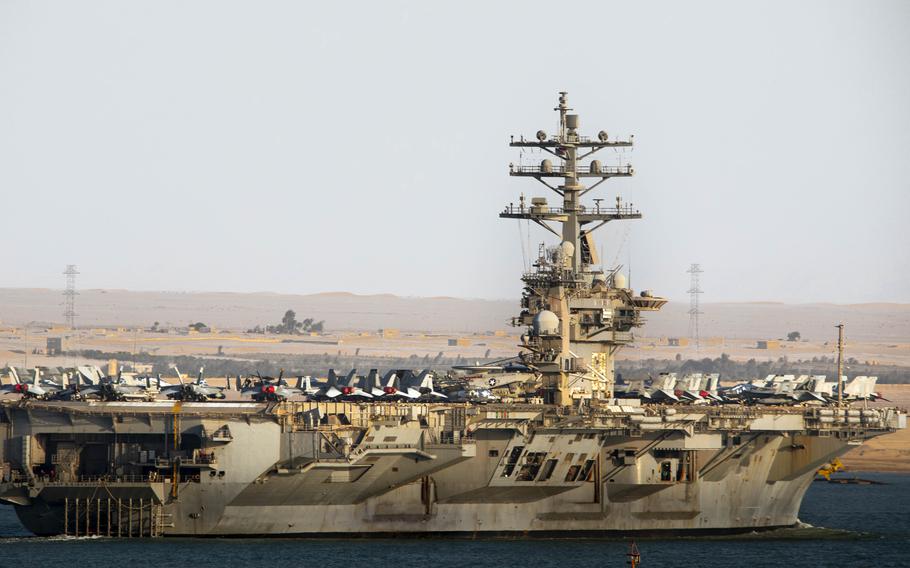
The USS Dwight D. Eisenhower transits the Suez Canal in November 2023. (Keith Nowak/U.S. Navy)
The USS Dwight D. Eisenhower will remain in service through the decade’s end, shelving plans that once called for the second-oldest Nimitz-class aircraft carrier to leave the fleet as early as 2027, according to Navy officials.
The Navy announced in April 2022 that it would retire the USS Nimitz in 2025. The oldest of the 10 nuclear-powered carriers of the class, the Nimitz had joined the fleet in 1975, just days after the fall of Saigon ended the Vietnam War.
The Nimitz would be followed two years later by the Eisenhower, which was commissioned in October 1977.
“As the Navy continues to accept Gerald R. Ford-class carriers, we will remain a ready, agile force to compete and win around the world at any time,” the Navy announced in 2022.
Delays in the delivery and production of the Ford-class carriers led to delays in retirement dates for the two Nimitz-class carriers, each pushed back a full year, according to a 2023 Navy announcement. The plan was for the Nimitz to leave service in 2026, and the Eisenhower would retire in 2028.
On Monday, the Navy said the Nimitz would still leave the Navy as planned in 2026. The carrier is now undergoing maintenance at the Puget Sound Naval Shipyard in Bremerton, Wash.
However, the Eisenhower will remain at least through 2029, the Navy said.
The second carrier of the Ford class, the USS John F. Kennedy, would be the first of the projected 10 Ford-class carriers to have a magnet rail system to launch aircraft from its deck. It would take the place of the steam-power catapults now used on carriers.
Development of the launching system and other systems has led to delays, pushing the delivery date of the John F. Kennedy from June 2024 to July 2025.
Though the former USS Enterprise was decommissioned in 2012, it took the Navy until September 2023 to announce a plan to send it to a commercial shipyard to have its eight nuclear reactors defueled and broken down and the radioactive components shipped to safe storage.
Maritime Executive magazine wrote earlier this year that the techniques and timing of the work will impact when a shipyard can start work on a similar dismantling of the Nimitz.
Two additional Ford-class carriers are under construction at the Huntington-Ingalls shipyard in Newport News, Va.: the new USS Enterprise and the USS Doris Miller — named after the Black sailor who received the Navy Cross for heroism at Pearl Harbor in World War II.
The Enterprise is scheduled to be commissioned in 2029. Under earlier plans, its arrival would coincide with the departure of the Eisenhower from the fleet.
But the Navy will now keep the Eisenhower in service, giving the Navy nine Nimitz-class carriers and three Ford-class carriers.
The Doris Miller is slated for commissioning in 2032 and an as-yet-unnamed carrier will be commissioned in 2036.
Mark Cancian, a retired Marine colonel now a senior adviser with the Center for Strategic and International Studies in Washington, D.C., said keeping the Eisenhower beyond the original timeline for its retirement gives the Navy flexibility.
“It would help avoid that gap between when you plan on retiring the Eisenhower and when the Kennedy and other Ford-class carriers are ready to deploy,” he said.
Cancian said building and dismantling 100,000-ton nuclear aircraft carriers was technologically tricky. Tying the delivery of a new class of carriers to when existing carriers can retire is a complex timeline.
“There is tension if you retire carriers on time and there are delays with replacements,” he said. “You could end up with 10 carriers instead of 11 or 12. To be fair to the Navy, the president is always going to call on them to go anywhere in the world.”
If the demand and supply of carriers are inadequate, having enough task forces to deal with multiple conflicts would be tough. The ships require long mid-life nuclear reactor refueling and regular maintenance. The Navy’s fiscal 2025 budget shows the first of the service’s class of supercarriers, the USS Gerald R. Ford, will go to the Puget Sound Naval Shipyard for a $182.2 million electrical upgrade.
But the United States needed carriers to respond to simultaneous threats of Russia’s invasion of Ukraine, protecting shipping in the eastern Mediterranean and Red Sea from the spillover of the conflict between Israel and Hamas, as well as the increasingly assertive military posture of China in the Indo-Pacific region.
The Eisenhower was called on to move out of its home port in Norfolk, Va., on Oct. 14, joining the guided-missile cruiser USS Philippine Sea and guided-missile destroyers USS Gravely and USS Mason to stop Houthi missile attacks on shipping.
The Gerald Ford was stationed in the Eastern Mediterranean, allowing the two carriers to serve as defensive bookends on either side of the Suez Canal, where the Navy said 16% of world commerce flows through on ships.
The Navy plans to build 10 Ford-class carriers to replace the 10 Nimitz-class carriers, which were commissioned between April 1975 and January 2009.
“The [Enterprise] delivery date is September 2029. The [Doris Miller] delivery date is February 2032.” said Lt. j.g. Luke Bienstock, a Navy spokesman at the Pentagon.
Those are long waits in a world in conflict, Cancian said.
“Policy may say, ‘Focus on the Pacific, don’t get distracted in the Middle East or Europe,’ ” he said. “But the world keeps intruding. We can’t say, ‘No, no, we’re not going to support our allies’ when there is trouble.”
Cancian said one way to deal with multiple challenges is to keep carriers around longer than the original 50 years that they were meant to operate.
“As long as commitments remain high,” he said. “You squeeze some more life out of the carriers we have.”